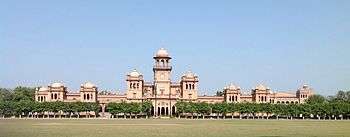Peshawar
Peshawar
The City of Flowers | ||||||
|---|---|---|---|---|---|---|
| Metropolis | ||||||
| ||||||
 Peshawar Location within Pakistan | ||||||
| Coordinates: 34°01′N 71°35′E / 34.017°N 71.583°ECoordinates: 34°01′N 71°35′E / 34.017°N 71.583°E | ||||||
| Country |
| |||||
| Province |
| |||||
| District | Peshawar District | |||||
| Union Councils | 92 | |||||
| Government | ||||||
| • Type | Metropolitan city | |||||
| • Mayor of Peshawar | Arbab Asim | |||||
| • Deputy Mayor of Peshawar | Syed Qasim Ali Shah | |||||
| • Deputy Commissioner Peshawar | Riaz Khan Mahsud | |||||
| • Assistant Commissioner Peshawar | Altaf Ahmad Sheikh | |||||
| Area | ||||||
| • Total | 1,257 km2 (485 sq mi) | |||||
| Elevation | 359 m (1,178 ft) | |||||
| Highest elevation | 450 m (1,480 ft) | |||||
| Population (2014)[1] | ||||||
| • Total | 1,755,000 | |||||
| • Density | 1,400/km2 (3,600/sq mi) | |||||
| Peshawar Urban agglomeration | ||||||
| Time zone | PKT (UTC+5) | |||||
| Area code(s) | 091 | |||||
| Languages | Punjabi (Hindko dialect),[2] Pashto | |||||
Peshawar (Urdu: پشاور; Pashto: پېښور) is the capital of the Khyber Pakhtunkhwa province of Pakistan.[3] It is the largest city of Khyber Pakhtunkhwa, and according to the 1998 census was the ninth-largest city of Pakistan.[4] Peshawar is a metropolitan city and the administrative centre and economic hub for the Federally Administered Tribal Areas of Pakistan.[5] Peshawar is situated in a large valley near the eastern end of the Khyber Pass, close to the Pak-Afghan border. Peshawar is irrigated by various canals of the Kabul River and by its right tributary, the Bara River.
Peshawar's recorded history dates back to at least 539 BC, making it the oldest city in Pakistan and one of the oldest in South Asia.[6]
History

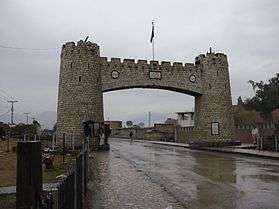
Ancient Peshawar
Peshawar was known in Sanskrit as Puruṣapura (पुरूषपुर), literally meaning "city of men".[lower-alpha 1] It also found mention in the Zend Avesta as Vaēkərəta, the seventh most beautiful place on earth created by Ahura Mazda It was known as the "crown jewel" of Bactria and also held sway over Takshashila (modern Taxila).[7] Being among the most ancient cities of the region between Central and South Asia, Peshawar has for centuries been a center of trade between Bactria, South Asia and Central Asia. As an ancient center of learning, the 2nd century BC. Bakhshali Manuscript used in the Bakhshali approximation was found nearby.[8]
Vedic mythology refers to an ancient settlement called Pushkalavati in the area, after Pushkal, presently known as Charsadda.[9] In recorded history, the earliest major city established in the general area of Peshawar was called Puruṣapura (Sanskrit for City of Men), from which the current name "Peshawar" is likely derived and was western capital of Ghandhara civilization after Pushkalavati.[2][10]
The area that Peshawar occupies was then seized by the Greco-Bactrian king, Eucratides (170 – 159 BC), and was controlled by a series of Greco-Bactrian, and later, Indo-Greek kings, who ruled an empire that geographically spanned from the area of present-day Afghanistan to North India. Later, the city was ruled by several Parthian and Indo-Parthian kings, another group of Iranian peoples germane to the region, the most famous of whom, Gondophares, ruled the city and its environs, starting in circa AD 46; the period of rule by Gondophares was briefly followed by two or three of his descendants, before they were displaced by the first of the "Great Kushans", Kujula Kadphises, around the middle of the 1st century AD.[11]
According to the historian, Tertius Chandler, Peshawar consisted of a population of 120,000 in the year AD 100, making it a major city and the seventh-most populous city in the world at the time.[12]
Gandharan Peshawar (c. 127–1001)
The city was then conquered by the Kushans, a Central Asian tribe of Tocharian origin. The Kushan King Kanishka the Great, who ruled from AD 127, moved the capital from Pushkalavati (present-day Charsadda district, in the Peshawar Valley) to Gandhara (Peshawar city) in the 2nd century AD.[13]
The giant Kanishka stupa at Peshawar, which was one of the tallest buildings in the world at the time, was built by King Kanishka to house Buddhist relics just outside the present-day Ganj Gate of the old city of Peshawar. The Kanishka stupa was said to be an imposing structure, as one traveled down from the Hindu Kush mountains onto the Gandharan plains. The earliest account of the famous building was documented by Faxian, the Chinese Buddhist pilgrim, who was also a monk, who visited the structure in AD 400 and described it as being over 40 chang in height (approximately 120 metres (390 ft)) and adorned "with all precious substances". A jeweled casket containing relics of the Gautama Buddha, and an inscription identifying Kanishka as the donor, existed at the ruined base of this giant stupa — the casket was excavated, by a team supervised by Dr D.B. Spooner in 1909, from a chamber under the very centre of the stupa's base.[14]
Muslim conquest
The Buddhist and Zoroastrian Pashtuns began converting to Islam following the early annexation by the Arab Empire from Khurasan (in what is Afghanistan, Turkmenistan and northeastern Iran) and the incursions into the subcontinent. This culminated until the demise of the Hindu Shahis.
Mughal rule (1451–1747)
Peshawar was a northwestern regional center of the Pashtun Lodi Empire which was founded by Bahlul Lodi in 1451 and centered at Delhi. Peshawar was also incorporated into the Mughal domains by the middle of the sixteenth century. The founder of the Mughul dynasty that would conquer South Asia, Babur, who hailed from the area that is currently Uzbekistan, arrived in Peshawar and founded a city called Bagram, where he rebuilt a fort in AD 1530. The Muslim technocrats, bureaucrats, soldiers, traders, scientists, architects, teachers, theologians and Sufis flocked from the rest of the Muslim world to the Islamic Sultanate in South Asia, with many settling in the Peshawar region.[9]
Durrani Peshawar (1747–1818)
As Mughal power declined in 1747, following a loya jirga, Peshawar would join the Pashtun Durrani Empire of Ahmad Shah Durrani.[15] Peshawar was attacked and briefly held by the Maratha Empire of western India, which conquered Peshawar on 8 May 1758. A large force of Pashtuns under Ahmad Shah Durrani then re-conquered Peshawar in early 1759.[16] Peshawar remained under Afghan (Durrani) rule till the conquest by the Sikhs in 1818.
In 1776, Ahmad Shah's son, Timur Shah Durrani, chose Peshawar as his winter capital[17] and the Bala Hissar Fort in Peshawar was used as the residence of Durrani kings. Pashtuns from Peshawar participated in the incursions of South Asia during the Durrani Empire. Peshawar remained the winter capital until the Sikhs of the Punjab region rose to power in the early nineteenth century.[18]
Sikh conquest (1818–1849)
Until 1818, Peshawar was controlled by Afghanistan, but was invaded by the Sikh Empire of Lahore. The arrival of a party led by British explorer and former agent of the East India Company, William Moorcroft was seen as an advantage, both in dealings with Kabul and for protection against the Sikhs of Lahore. Moorcroft continued to Kabul in the company of Peshawari horses and thence to the Hindu Kush.[19] In 1818, Peshawar was captured by Maharaja Ranjit Singh and paid a nominal tribute until it was finally annexed in 1834 by the Sikhs, after which the city fell into steep decline. Many of Peshawar's famous Mosques and gardens were destroyed by the Sikhs at this time. An Italian was appointed by the Sikhs as administrator. Acting on behalf of the Sikhs, Paolo Avitabile, unleashed a reign of fear – his time in Peshawar is known as a time of "gallows and gibbets." The city's famous Mahabat Khan, built in 1630 in the Jeweler's Bazaar, was badly damaged and desecrated by the Sikh conquerors.[20]
The Gurdwara Bhai Joga Singh and Gurdwara Bhai Beeba Singh were constructed in the city by Hari Singh Nalwa to accommodate the influx of Sikh immigrants from the Punjab.[21] While the city's Sikh population drastically declined after the partition of British India, Peshawar's Sikh community has re-established itself, bolstered by Sikh refugees and by approximately 4,000 refugees from the Tribal Areas;[22] in 2008, the largest Sikh population in the Pakistan was located in Peshawar Khyber Pakhtunkhwa.[23] Sikhs in Peshawar self-identify as Pashtuns and speak Pashto as their mother tongues.[24]
British Empire (1849–1947)
Following the defeat of the Sikhs in the Second Anglo-Sikh War in 1849, territories in the Punjab were also captured by the British East India Company. During the Sepoy Rebellion of 1857, the 4,000 members of the native garrison were disarmed without bloodshed;[25] the absence of brutality meant that Peshawar was not affected by the widespread devastation that was experienced throughout the rest of British India and local chieftains sided with the British after the incident.[26] British control remained confined within the city walls as vast regions of the Frontier province outside the city were claimed by the Kingdom of Afghanistan. The vast mountainous areas outside of the city were mapped out only in 1893 by Sir Mortimer Durand, foreign secretary of the British Indian government, who collaboratively demarcated the boundary of British-controlled areas with the Afghan ruler at the time, Abdur Rahman Khan.

The British laid out the vast Peshawar Cantonment to the west of the city in 1868, and made the city its frontier headquarters.[16] Additionally, several projects were initiated in Peshawar, including linkage of the city by railway to the rest of British India and renovation of the Mohabbat Khan mosque that had been desecrated by the Sikhs.[20] The British also constructed Cunningham clock tower, in celebration of the Golden Jubilee of Queen Victoria, and, in 1906, constructed Victoria Hall (now home of the Peshawar Museum) in memory of Queen Victoria.[20] The British greatly contributed to the establishment of Western-style education in Peshawar with the establishment of Edwardes College and Islamia College in 1901 and 1913, respectively—these were established in addition to numerous other schools, many of which are run by the Anglican Church.[20] For better administration of the region, Peshawar and the adjoining districts were separated from the Punjab Province in 1901.[27]
Peshawar emerged as a centre for both Hindko and Pashtun intellectuals. Hindko speakers, also referred to as Khaarian ("city dwellers" in Pashto), were responsible for the dominant culture for most of the time that Peshawar was under British rule.[28] Where as before it was the Pashtuns and Mughals who beautified and brought culture to the region, until the Sikhs brought the city to shambles and deterioration.
Peshawar was the scene of a non-violent resistance movement that was led by Ghaffar Khan, a disciple of Mohandas Gandhi. In April 1930, Khan led a large group of locals, in a peaceful protest in Qissa Khawani Bazaar, against discriminatory laws that had been enacted by the British rulers — hundreds were killed when British troops opened fire on the demonstrators.[29]
Modern Peshawar
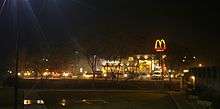

In 1947, Peshawar became part of the newly created Pakistan. Until the mid-1950s, Peshawar was enclosed within a city wall and sixteen gates. Of the old city gates, the most famous was the "Kabuli Gate", and in January 2012, an announcement was made by Siraj Ahmed Khan, the Peshawar District Coordination Officer at the time: "In due course of time, all the gates around the old city will be restored." — Imran Rasheed, an author who has written extensively on the history of Peshawar has explained:
Old Peshawar was divided into three separate walled communities, Gunj, Dhaki Nalbandi and Sard Chah quarters. Under the Sikhs, the Italian mercenary governor of Peshawar, General Paolo Avitabile, popularly known as Abu Tabela, demolished the walls around these quarters and built a single wall around the old city.[30]
Peshawar's size infrastructure has not developed adequately for the city's growing population, resulting in overcrowding. In addition to the increase in population, the high number of Afghan transportation vehicles that pass through the city have contributed to the degradation of the city's air quality:
There was a total of approximately 100,000 Afghans registered in Peshawar during the 1988 election, when Benazir Bhutto was running for Prime Minister of Pakistan; although, in addition to this estimate, hundreds of thousands of Afghan refugees were in the city illegally.[31]

As of 2012, Peshawar continues to link Pakistan with Afghanistan and Central Asia. Peshawar has emerged as an important regional city of Pakistan and the city remains a focal point for Pashtun culture.
Like the surrounding region, Peshawar has been at the crossroads of an armed struggle between the extremist Taliban, moderates, liberals, and Pashtun nationalists. Local poets' shrines have been targeted by the Pakistani Taliban, who bombed the shrine of the Pashtun poet Rahman Baba in 2009.[32] Other high-profile terrorist attacks in Peshawar have included the suicide bomb attack that took place at historic All Saints Church in September 2013, and the Peshawar school massacre that claimed the lives of 132 school children in December 2014.
Geography and climate
Climate
Peshawar features a semi-arid climate, with very hot summers and mild winters. Winter in Peshawar starts in November and ends in late March, though it sometimes extends into mid-April, while the summer months are from mid-May to mid-September. The mean maximum summer temperature surpasses 40 °C (104 °F) during the hottest month, and the mean minimum temperature is 25 °C (77 °F). The mean minimum temperature during the coolest month is 4 °C (39 °F), while the maximum is 18.3 °C (64.9 °F).
Peshawar is not a monsoon region, unlike other parts of Pakistan; however, rainfall occurs in both winter and summer. Due to western disturbances, the winter rainfall shows a higher record between the months of February and April. The highest amount of winter rainfall, measuring 236 millimetres (9.3 in), was recorded in February 2007,[33] while the highest summer rainfall of 402 millimetres (15.8 in) was recorded in July 2010;[34] during this month, a record-breaking rainfall level of 274 millimetres (10.8 in) fell within a 24-hour period on 29 July 2010[34] — the previous record was 187 millimetres (7.4 in) of rain, recorded in April 2009.[33] The average winter rainfall levels are higher than those of summer. Based on a 30-year record, the average annual precipitation level was recorded as 400 millimetres (16 in) and the highest annual rainfall level of 904.5 millimetres (35.61 in) was recorded in 2003.[33] Wind speeds vary during the year, from 5 knots (5.8 mph; 9.3 km/h) in December to 24 knots (28 mph; 44 km/h) in June. The relative humidity varies from 46% in June to 76% in August. The highest temperature of 50 °C (122 °F) was recorded on 18 June 1995,[33] while the lowest −3.9 °C (25.0 °F) occurred on 7 January 1970.[33]
| Climate data for Peshawar (1961–1990) | |||||||||||||
|---|---|---|---|---|---|---|---|---|---|---|---|---|---|
| Month | Jan | Feb | Mar | Apr | May | Jun | Jul | Aug | Sep | Oct | Nov | Dec | Year |
| Record high °C (°F) | 27.0 (80.6) |
30.0 (86) |
36.0 (96.8) |
42.2 (108) |
45.2 (113.4) |
48.0 (118.4) |
46.6 (115.9) |
46.0 (114.8) |
42.0 (107.6) |
38.5 (101.3) |
35.0 (95) |
29.0 (84.2) |
48 (118.4) |
| Average high °C (°F) | 18.3 (64.9) |
19.5 (67.1) |
23.7 (74.7) |
30.0 (86) |
35.9 (96.6) |
40.4 (104.7) |
37.7 (99.9) |
35.7 (96.3) |
35.0 (95) |
31.2 (88.2) |
25.6 (78.1) |
20.1 (68.2) |
29.4 (84.9) |
| Daily mean °C (°F) | 11.2 (52.2) |
12.9 (55.2) |
17.4 (63.3) |
23.2 (73.8) |
28.6 (83.5) |
33.1 (91.6) |
32.2 (90) |
30.7 (87.3) |
28.9 (84) |
23.7 (74.7) |
17.6 (63.7) |
12.5 (54.5) |
22.7 (72.9) |
| Average low °C (°F) | 4.0 (39.2) |
6.3 (43.3) |
11.2 (52.2) |
16.4 (61.5) |
21.3 (70.3) |
25.7 (78.3) |
26.6 (79.9) |
25.7 (78.3) |
22.7 (72.9) |
16.1 (61) |
7.6 (45.7) |
4.9 (40.8) |
15.9 (60.6) |
| Record low °C (°F) | −3.9 (25) |
−1.0 (30.2) |
1.7 (35.1) |
6.7 (44.1) |
11.7 (53.1) |
13.3 (55.9) |
18.0 (64.4) |
19.4 (66.9) |
12.0 (53.6) |
8.3 (46.9) |
1.1 (34) |
−1.3 (29.7) |
−3.9 (25) |
| Average precipitation mm (inches) | 26.0 (1.024) |
42.7 (1.681) |
78.4 (3.087) |
48.9 (1.925) |
27.0 (1.063) |
7.7 (0.303) |
42.3 (1.665) |
67.7 (2.665) |
17.9 (0.705) |
9.7 (0.382) |
12.3 (0.484) |
23.3 (0.917) |
403.9 (15.901) |
| Mean monthly sunshine hours | 195.5 | 189.5 | 194.5 | 231.3 | 297.1 | 299.5 | 273.8 | 263.2 | 257.3 | 266.1 | 234.8 | 184.4 | 2,887 |
| Source #1: NOAA (1961-1990) [35] | |||||||||||||
| Source #2: PMD[36] | |||||||||||||
Demographics
Peshawar is a rapidly growing city, with the district population at 2,982,816 in 1998.[37] The current population growth rate is 3.29% per year, a rate that is higher than the average of many other Pakistani cities. The average annual growth rate is 3.56%.[38]
Majority of the city residents speak Pashto and Hindko, a Punjabi dialect, is also spoken.[2] Hindko is mostly spoken in old parts of the city whereas Pashto is spoken in new areas. "Peshawari Hindko" is more similar to other Lahnda varieties of Punjabi but distinctive from Hindko spoken in other areas including "Hindko proper" and "Hindki of Hazara".[39]
The three main religious minorities are Hindus, Sikhs, and Christians. Hindus and Sikhs of Peshawar are fluent in Pashto and Punjabi languages while Christians speak Urdu, Punjabi and Pashto.[40]
Culture
With the Soviet war in Afghanistan in the 1980s and the influx of Afghan refugees into Pakistan, Peshawar became home for many Afghan musicians and artists.[41]
Following the election of the Muttahida Majlis-e-Amal (MMA) Islamic coalition in 2002, restrictions on public musical performances were introduced, as well as a ban prohibiting the playing of recorded music on public transport; however, a thriving underground scene has developed in Peshawar.[42] In 2008, the secular political party, the Awami National Party (ANP), swept elections and won power from the Islamic coalition. Since the ANP assumed power in Peshawar, a greater focus has shifted towards the areas of culture and the arts, but the party has been hindered by a well-established conservatism among the population and the Taliban militancy. In June 2012, a Pashto singer, Ghazala Javed, and her father were killed in the city, with the subsequent investigation revealing that the pair were murdered. Javed's career was very successful and her death occurred close to three years after the death of another promising Pashto musical artist, Aiyman Udas, who was also murdered in a fringe area of the city. Such incidents have been associated with Peshawar's conservative culture and the influence of the Taliban, the latter being the reason for Javed's movement to Peshawar, as the Taliban had strengthened its presence in the Peshawar Valley in 2007.[43]
Historically, the old city of Peshawar was a heavily guarded citadel that consisted of high walls. In the 21st century, only remnants of the walls remain, but the houses and havelis continue to be structures of significance. Most of the houses are constructed of unbaked bricks, with the incorporation of wooden structures for protection against earthquakes, with many composed of wooden doors and latticed wooden balconies. Numerous examples of the city's old architecture can still be seen in areas such as Sethi Mohallah. In the old city, located in inner-Peshawar, many historic monuments and bazaars exist in the 21st century, including the Mohabbat Khan Mosque, Kotla Mohsin Khan, Chowk Yadgar and the Qissa Khawani Bazaar. Due to the damage caused by rapid growth and development, the old walled city has been identified as an area that urgently requires restoration and protection. Author, Dr Raj Wali Shah Khattak, a former director of the Pushto Academy and a senior academic at the University of Peshawar, has written in his book, An Intangible Heritage: The Walled City of Peshawar:
To protect the inheritance of the walled city of Peshawar, the establishment of a heritage centre should be a priority. The centre should have audio and visual documentation equipment so that every aspect of culture and life, be it folklore, music, types of instruments, stories, etc., can be recorded. Moreover, visual documentation of customs and traditions should include marriage functions, clothing, lifestyle, manners and habits. Research into the oral nature of life in the bazars and streets, both during the day and at night, should be carried out to preserve this historical record. Fairs, festivals and traditions, both secular and religious, should be included in this record.[44]
The walled city was surrounded by several main gates that served as the main entry points into the city — in January 2012, an announcement was made that the government plans to address the damage that has left the gates largely non-existent over time, with all of the gates targeted for restoration.[30]
Education
Numerous educational institutes — schools, colleges and universities — are located in Peshawar. The University of Peshawar (UOP) was established in October 1950 by the first Prime Minister of Pakistan. Edwardes College, founded in 1900 by Herbert Edwardes, is the oldest college in the province.
The following is a list of some of the public and private universities in Peshawar:
- Islamia College University
- University of Peshawar
- Khyber Medical University
- University of Engineering and Technology, Peshawar
- Agricultural University (Peshawar)
- National University of Computer and Emerging Sciences, Peshawar Campus (NU-FAST)
- IMSciences (Institute of Management Sciences)
- Gandhara University
- Iqra National University, Peshawar (Formerly Peshawar Campus of Iqra University Karachi)
- Qurtuba University (Qurtuba University of Science & Information Technology)
- Sarhad University of Science and Information Technology
- CECOS University of IT and Emerging Sciences
- Preston University
- City University of Science and Information Technology, Peshawar
- Frontier Women University
- Abasyn University (Abasyn University, Peshawar)
Landmarks
The following is a list of other significant landmarks in the city that still exist in the 21st century:
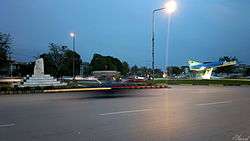

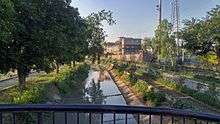
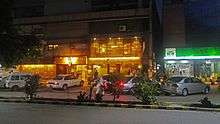
- General
- Governor's House
- Peshawar Garrison Club
- Kotla Mohsin Khan – the residence of Mazullah Khan, 17th century Pashtu poet
- Qissa Khwani Bazaar
- Kapoor Haveli Residence of Prithviraj Kapoor – famous Bollywood actor
- Forts
- Colonial monuments
- Chowk Yadgar (formerly the "Hastings Memorial")
- Cunningham clock tower – built in 1900 and called "Ghanta Ghar"
- Buddhist
- Gorkhatri – an ancient site of Buddha's alms or begging bowl, and the headquarters of Syed Ahmad Shaheed, Governor Avitabile
- Pashto Academy – the site of an ancient Buddhist university
- Shahji ki Dheri – the site of King Kanishka's famous Buddhist stupa. It was once the tallest stupa in India and served as the model for pagodas in China and Japan. The site is now a slum located outside the Gunj Gate of the old Walled City called Akhunabad.[45][46] The stupa was described by Chinese pilgrims in the 7th century as the tallest stupa in all India with a height of 591–689 feet.
- Hindu
- Sikh
- Sikh Gurudwara at Jogan Shah
- Parks
- Army Stadium – composed of an amusement park for children and families, restaurants, banks, play pens and a shopping arcade
- Wazir Bagh – laid in 1802, by Fatteh Khan, Prime Minister of Shah Mahmud Khan
- Ali Mardan Khan Gardens (also known as Khalid bin Waleed Park) – formerly named "Company Bagh"
- Shahi Bagh – a small portion constitutes the site of Arbab Niaz Stadium
- Mosques
- Museums
Transport
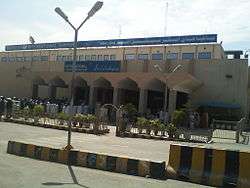
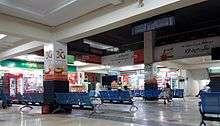
Peshawar International Airport ( د پېښور نړیوال هوائی ډګر ), is an international airport located in the city of Peshawar in the Khyber Pakhtunkhwa province of Pakistan. Located about a 10-minute drive from the centre of Peshawar. The Daewoo Express bus terminal is located at G.T. Road. Peshawar Cantonment railway station and Peshawar City railway station provide train services in Peshawar.
Sports
Arbab Niaz Stadium is the test cricket ground of Peshawar. Other stadiums are Army Stadium, Peshawar Club Ground and Qayyum Stadium. Cricket is the most popular sport in Peshawar and the city is home to the domestic team, Peshawar Panthers while Peshawar Zalmi represents Peshawar and the province of Khyber Pakhtunkhwa overall in Pakistan Super League. Hockey and squash are also popular in Peshawar. Shahi Bagh is available for general public for various out door games.
Neighbourhoods
Sport Players
- Umar Gul, cricketer
- Yasir Hameed, cricketer
- Musaddiq Hussain, hockey player
- Jahangir Khan, squash player
- Jansher Khan, squash player
- Mohibullah Khan, squash player
- Aamir Atlas Khan, squash player
- Hashim Khan, squash player
- Roshan Khan, squash player
- Arshad Khan, cricketer
- Kabir Khan, cricketer
- Farhan Mehboob, squash player
- Torsam Khan Squash Player
- Mohammad Rizwan Cricket Player[51][52]
- Zakir Khan, Cricketer
Gallery
- Office Islamia College
- Lady Reading Hospital Peshawar
- Clock Tower of Peshawar city known as "Ghanta Ghar" (Clock Home) in Urdu
- Flower work inside Mohabbat Khan Mosque
- Sunehri Mosque
 Sethi Mohallah
Sethi Mohallah
Twin towns – Sister cities
Peshawar is twinned with:
See also
Notes
- ↑ From Sanskrit puruṣa, "(primordial) man", and pura, "city".
References
- ↑ http://www.demographia.com/db-worldua.pdf
- 1 2 3 "NWFP in search of a name". pakhtunkhwa.com. Retrieved 24 January 2016.
- ↑ "NWFP Introduction". Government of Khyber-Pakhtunkhwa. Archived from the original on 30 October 2007. Retrieved 12 December 2007.
- ↑ "Population size and growth of major cities" (PDF). Pakistan Bureau of Statistics. 1998.
- ↑ "Administrative System". Government of the Federally Administered Tribal Areas. Retrieved 12 December 2007.
- ↑ Peshawar: Oldest continuously inhabited City in South Asia. DAWN.com. Retrieved 17 October 2014.
- ↑ Encyclopædia Britannica: Gandhara
- ↑ Ian Pearce (May 2002). "The Bakhshali manuscript". The MacTutor History of Mathematics archive. Retrieved 24 July 2007.
- 1 2 The Pathans – 550 BC – AD 1957 by Sir Olaf Caroe, 1958, Macmillan Company, Reprinted Oxford University Press, 2003
- ↑ Journal of the Royal Asiatic Society of Great Britain & Ireland. Royal Asiatic Society of Great Britain & Ireland. 1834. pp. 114–. Retrieved 13 December 2012.
- ↑ "Provincial Capital". Government of the Khyber-Pakhtunkhwa. Archived from the original on 30 October 2007. Retrieved 12 December 2007.
- ↑ Matt Rosenberg; Tertius Chandler (2012). "Top 10 Cities of the Year 100". About.com: Education > Geography (sourced from Four Thousand Years of Urban Growth: An Historical Census by Tertius Chandler. 1987, St. David's University Press). About.com. Retrieved 13 December 2012.
- ↑ "Pushpapura to Peshawar". The Khyber Watch. Retrieved 25 November 2009.
- ↑ Rai Govind Chandra (1 January 1979). Indo-Greek Jewellery. Abhinav Publications. pp. 82–. ISBN 978-81-7017-088-4. Retrieved 13 December 2012.
- ↑ "A Concise History of Afghanistan in 25 Volumes, Volume 14". Retrieved 29 December 2014.
- 1 2 Schofield, Victoria, "Afghan Frontier: Feuding and Fighting in Central Asia", London: Tauris Parke Paperbacks (2003), page 47
- ↑ Shah Hanifi (11 February 2011). Connecting Histories in Afghanistan: Market Relations and State Formation on a Colonial Frontier. Stanford University Press. ISBN 978-0-8047-7777-3. Retrieved 13 December 2012.
Timur Shah transferred the Durrani capital from Qandahar during the period of 1775 and 1776. Kabul and Peshawar then shared time as the dual capital cities of Durrani, the former during the summer and the latter during the winter season.
- ↑ Caroe, Olaf (1957) The Pathans.
- ↑ Keay, John (1996). Explorers of the Western Himalayas: 1820–1895. London: John Murray. p. 41. ISBN 0-7195-5576-0.
- 1 2 3 4 Asghar Javed (1999–2004). "History of Peshawar". National Fund for Cultural Heritage. National Fund for Cultural Heritage. Retrieved 13 December 2012.
- ↑ Iqbal Qaiser (2012). "Gurudwara Bhai Joga Singh at Peshawar". All About Sikhs – your Gateway to Sikhism. Gateway to Sikhism. Retrieved 13 December 2012.
- ↑ M Zulqernain (10 February 2012). "Historic Gurdwara in Peshawar to Reopen for Worship". Outlook India.com. The Outlook Group. Retrieved 13 December 2012.
- ↑ Rania Abouzeid (22 November 2010). "Pakistan: The Embattled Sikhs in Taliban Territory". Time World. Time Inc. Retrieved 13 December 2012.
- ↑ http://www.newslinemagazine.com/2008/10/the-frontier-singhs/[]
- ↑ John Pike (2000–2012). "Peshawar Cantonment". GlobalSecurity.org. GlobalSecurity.org. Retrieved 13 December 2012.
- ↑ Charles Allen, Soldier Sahibs, p.276
- ↑ Changes in the Socio-economic Structures in Rural North-West Pakistan By Mohammad Asif Khan Peshawar was separated from Punjab Province in 1901
- ↑ The Frontier Town of Peshawar. A Brief History by Sayed Amjad Hussain.
- ↑ APP (24 April 2008). "PESHAWAR: Qissa Khwani martyrs remembered". DAWN The Internet Edition. DAWN Media Group. Retrieved 13 December 2012.
- 1 2 Manzoor Ali (29 January 2012). "Restoring heritage: Kabuli Gate being rebuilt in old city". The Express Tribune. The Express Tribune News Network. Retrieved 13 December 2012.
- ↑ Donatella Lorch (16 November 1988). "Pakistan Restricts Afghan. Refugees". The New York Times. The New York Times Company. Retrieved 13 December 2012.
- ↑ Qaiser Felix (3 June 2009). "Sufi shrine bombed, in push to "Talibanize" Pakistan". AsiaNews.it. AsiaNews CF. Retrieved 13 December 2012.
- 1 2 3 4 5 "Peshawar Climate Data". PakMet. Climate Data Processing Centre (CDPC), Pakistan Meteorological Department, Karachi. Archived from the original on 13 June 2010. Retrieved 26 June 2016.
- 1 2 "RAINFALL STATEMENT JULY-2010". PakMet. Climate data Processing Centre (CDPC), Pakistan Meteorological Department, Karachi. Archived from the original on 20 August 2010. Retrieved 26 June 2016.
- ↑ "Peshawar Climate Normals 1961-1990". National Oceanic and Atmospheric Administration. Retrieved January 16, 2013.
- ↑ "Extremes of Peshawar". Pakistan Meteorological Department. Retrieved February 2, 2015.
- ↑ "KHYBER PAKHTUNKHWA IN FIGURES 2011". Khyber Pakhtunkhwa Bureau of Statistics. Government of Khyber Pakhtunkhw. 2012. Retrieved 13 December 2012.
- ↑ "About Peshawar: Demographics". epeshawar.com. epeshawar.com. 2012. Retrieved 13 December 2012.
- ↑ Kreyenbroek, Philip G. (19 May 2010). Oral Literature of Iranian Languages: Kurdish, Pashto, Balochi, Ossetic, Persian and Tajik: Companion Volume II: History of Persian Literature A, Volume 18. I.B.Tauris. p. 153. ISBN 0857718142.
- ↑ "Multi-tongued: Peshawar's happy Hindus and Sikhs". The Express Tribune. 22 April 2013. Retrieved 27 January 2016.
- ↑ Intikhab Amir (24 December 2001). "PESHAWAR: Refugee musicians keep Afghan music alive". DAWN The Internet Edition. DAWN Group of Newspapers. Retrieved 13 December 2012.
- ↑ Maria Tirmizi; Rizwan-ul-Haq (24 June 2007). "Peshawar underground: It's difficult to be a rock star in the land the epitomises conservatism, yet something shocking is happening. There is a rock scene waiting to burst out of the Khyber Pakhtunkhwa. Rahim Shah was just the beginning, Sajid and Zeeshan were proof that originality can spring out of unlikely places and there are others who are making their riffs and ragas heard... slowly, but surely.". The News on Sunday Instep. Retrieved 13 December 2012.
- ↑ Raza Rumi; Manzoor Ali (30 June 2012). "The Music Doesn't Stop in Peshawar". The Indian Express: Journalism of Courage. Retrieved 13 December 2012.
- ↑ Marwat, Fazal-ur-Rahim; Khattak, Raj Wali Shah (23 June 2005). "Whispering Heritage: Reviewed by Dr. Fazal-ur-Rahim Marwat". Khyber.org. Khyber Gateway. Retrieved 13 December 2012.
- ↑ http://tribune.com.pk/story/240321/gandhara-civilisation-revered-buddhist-site-rediscovered-near-peshawar/ Gandhara civilisation: Revered Buddhist site rediscovered near Peshawar By Manzoor Ali, 27 August 2011
- ↑ Peshawar faced with socio-cultural vacuum, Ghafar Ali, December 06, 2002
- ↑ The sacred four, Riaz Ahmad, 20 June 2013 http://tribune.com.pk/story/565613/the-sacred-four-the-decline-of-hindu-holy-sites-in-peshawar/
- ↑ Babur Nama Page 141 published by Penguin
- ↑ Ahmad, Riaz. "The sacred four: The decline of Hindu holy sites in Peshawar – The Express Tribune". Tribune.com.pk. Retrieved 3 August 2013.
- ↑ Professor Mohd Said (2003). "List of some Historical Monuments of Peshawar". Sarhad Conservation Network. Internet Archive Wayback Machine: Sarhad Conservation Network. Archived from the original on 27 October 2009. Retrieved 13 December 2012.
- ↑ "Mohammad Rizwan". pcb.com.pk. Retrieved 27 January 2016.
- ↑ "Mohammad Rizwan". Cricinfo. Retrieved 27 January 2016.
- ↑ Umer Farooq (6 January 2012). "Indonesia seeking to enhance trade with Khyber-Pakhtunkhwa". The Express Tribune. The Express Tribune News Network. Retrieved 13 December 2012.
Further reading
- Ahmad, Aisha and Boase, Roger. 2003. "Pashtun Tales from the Pakistan-Afghan Frontier: From the Pakistan-Afghan Frontier." Saqi Books (1 March 2003). ISBN 0-86356-438-0.
- Beal, Samuel. 1884. "Si-Yu-Ki: Buddhist Records of the Western World, by Hiuen Tsiang." 2 vols. Trans. by Samuel Beal. London. Reprint: Delhi. Oriental Books Reprint Corporation. 1969.
- Beal, Samuel. 1911. "The Life of Hiuen-Tsiang by the Shaman Hwui Li, with an Introduction containing an account of the Works of I-Tsing". Trans. by Samuel Beal. London. 1911. Reprint: Munshiram Manoharlal, New Delhi. 1973.
- Dani, Ahmad Hasan. 1985. "Peshawar: Historic city of the Frontier" Sang-e-Meel Publications (1995). ISBN 969-35-0554-9.
- Dobbins, K. Walton. 1971. "The Stūpa and Vihāra of Kanishka I". The Asiatic Society of Bengal Monograph Series, Vol. XVIII. Calcutta.
- Elphinstone, Mountstuart. 1815. "An account of the Kingdom of Caubul and its dependencies in Persia, Tartary, and India; comprising a view of the Afghaun nation." Akadem. Druck- u. Verlagsanst (1969).
- Foucher, M. A. 1901. "Notes sur la geographie ancienne du Gandhâra (commentaire à un chaptaire de Hiuen-Tsang)." BEFEO No. 4, Oct. 1901, pp. 322–369.
- Hargreaves, H. (1910–11): "Excavations at Shāh-jī-kī Dhērī"; Archaeological Survey of India, 1910–11, pp. 25–32.
- Hill, John E. 2003. "Annotated Translation of the Chapter on the Western Regions according to the Hou Hanshu." 2nd Draft Edition.
- Hill, John E. 2004. "The Peoples of the West from the Weilue" 魏略 by Yu Huan 魚豢: A Third Century Chinese Account Composed between 239 and 265 CE. Draft annotated English translation.
- Hopkirk, Peter. 1984. "The Great Game: The Struggle for Empire in Central Asia" Kodansha Globe; Reprint edition. ISBN 1-56836-022-3.
- Moorcroft, William and Trebeck, George. 1841. "Travels in the Himalayan Provinces of Hindustan and the Panjab; in Ladakh and Kashmir, in Peshawar, Kabul, Kunduz, and Bokhara... from 1819 to 1825", Vol. II. Reprint: New Delhi, Sagar Publications, 1971.
- Reeves, Richard. 1985. "Passage to Peshawar: Pakistan: Between the Hindu Kush and the Arabian Sea." Holiday House September 1985. ISBN 0-671-60539-9.
- Imran, Imran Rashid. 2006. "Baghaat-i-Peshawar." Sarhad Conservation Network. July 2006.
- Imran, Imran Rashid. 2012. "Peshawar - Faseel-e-Shehr aur Darwazay." Sarhad Conservation Network. March 2012.


